Spring Framework
What’s Spring
“Most popular application development framework for enterprise Java.”
History
- Come from J2EE problems
- Expert One-on-One J2EE Design and Development
- 2004 - Spring 1.0
- 2006 - Spring 2.0
- Improvement s in the IOC container and AOP
- Including @AspectJ annotation support for AOP development
- 2007 - Spring 2.5
- Annotation-driven configuration that requires component scanning to auto-detect annotated components
- Introduces annotations such as @RequestMapping, @RequestParam, and @ModelAttribute for MVC controllers
- 2009 - Spring 3.0
- Java-based configuration
- Supports REST in Spring MVC
History (cont)
- 2011 - Spring 3.1
- Cache abstraction
- Bean definition profiles
- 2011 - Spring 3.2
- Servlet 3-based asynchronous
- Testing of Spring MVC applications without a Servlet container
- Method annotated with @ExceptionHandler, @InitBinder, and @ModelAttribute can be added to a class annotated with the @ControllerAdvice annotation.
- Improvements in Spring 4.X include support for Java SE 8
- Groovy 2, and a few aspects of Java EE7.
Goals
Make J2EE easier to use
Make the common tasks easier
Promote good programming practice
You can focus on the domain problems
What is Spring today?
An open source application framework
Lightweight solution for enterprise applications
Extensible for other frameworks
De facto standard of Java Enterprise Application
Spring Modules
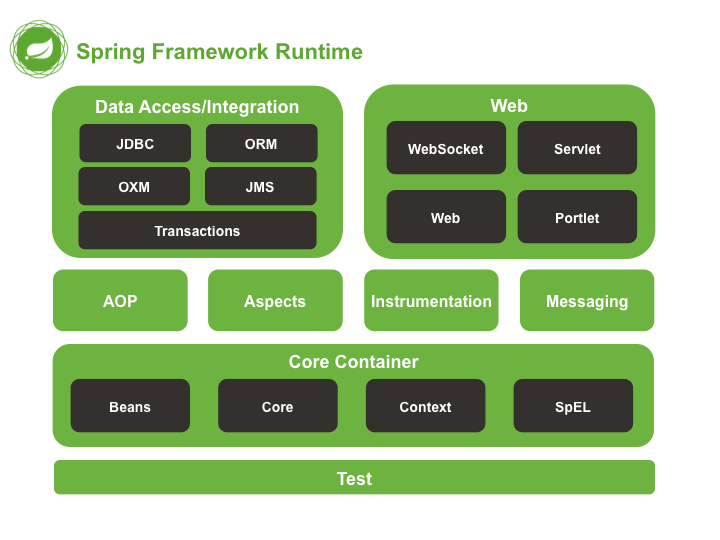
Core Container
Core and Beans
provide the fundamental parts of the framework, including IoC and Dependency Injection features Context
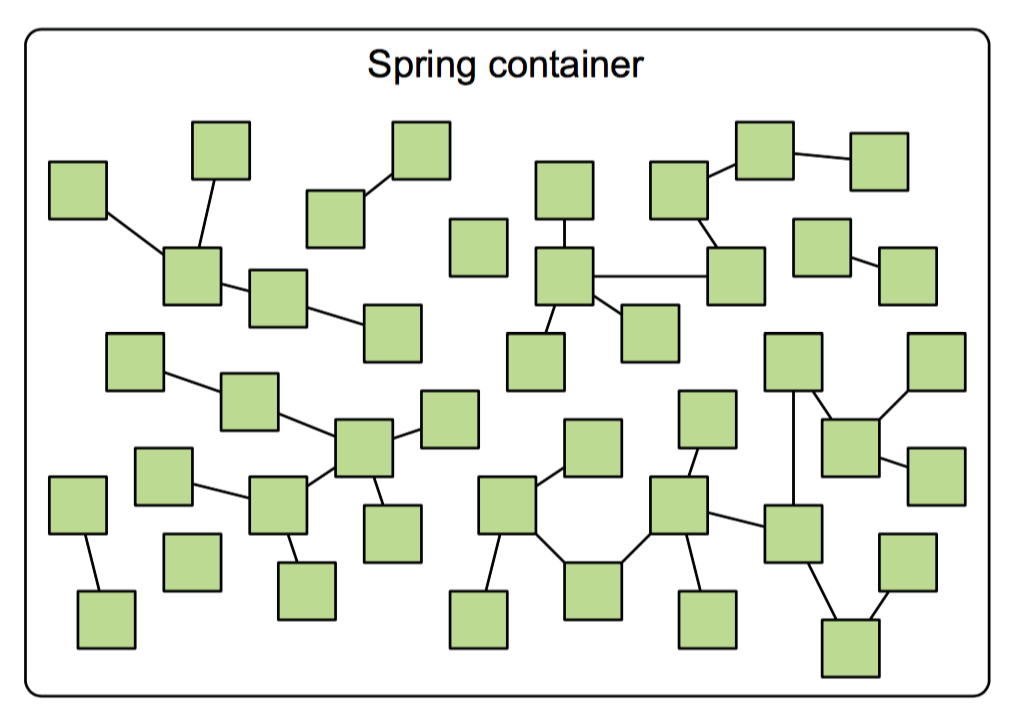
Context
it is a means to access objects in a framework-style manner that is similar to a JNDI Registry
Expression language
provides a powerful expression language for querying and manipulating an object graph at runtime
AOP
The spring-aop module provides an AOP Alliance-compliant aspect-oriented programming implementation allowing you to define,
for example, method interceptors and pointcuts to cleanly decouple code that implements functionality that should be separated.
Instrumentation
The spring-instrument module provides class instrumentation support and classloader implementations to be used in certain application servers.
The spring-instrument-tomcat module contains Spring’s instrumentation agent for Tomcat.
Data Access/Integration
- JDBC - provides a JDBC-abstraction layer
- ORM - provides integration layers for popular object-relational mapping APIs, including JPA, JDO, Hibernate and iBatis
- OXM - provides an abstraction layer that supports Object/XML mapping implementations for JAXB, Castor, XMLBeans, JiBX and XStream.
- JMS – contains features for producing and consuming messages.
- Transaction - supports programmatic and declarative transaction management
Test
- The spring-test module supports the unit testing and integration testing of Spring components with JUnit or TestNG.
- It provides consistent loading of Spring ApplicationContexts and caching of those contexts
- It also provides mock objects that you can use to test your code in isolation
Web Layer
The Web layer consists of the spring-web, spring-webmvc, spring-websocket, and spring-webmvc-portlet modules.
Full-fledged Spring web application
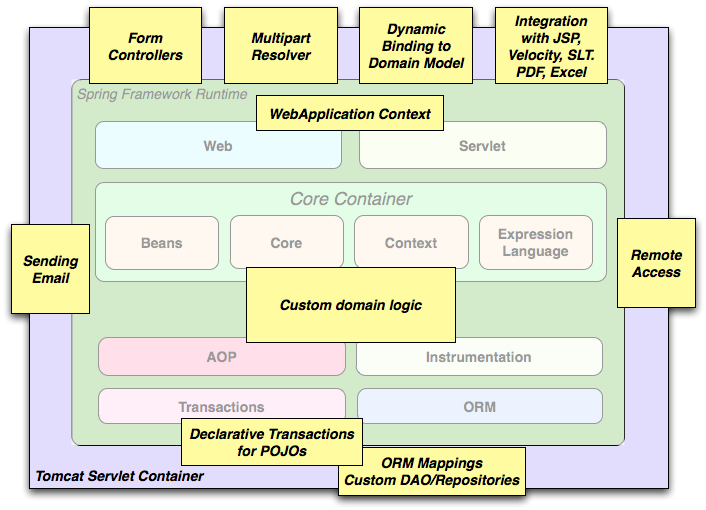
Inversion Of Control
What is IoC?
- is a concept in application development
- "don’t call me, I’ll call you“
- one form is Dependency Injection (DI)
Spring IoC Container
Spring IoC Container

The container gets its instructions on what objects to instantiate, configure,and assemble by reading configuration metadata provided.
The configuration metadata can be represented either by XML, Java annotations, Java-base configuration
Spring Container
Spring Container
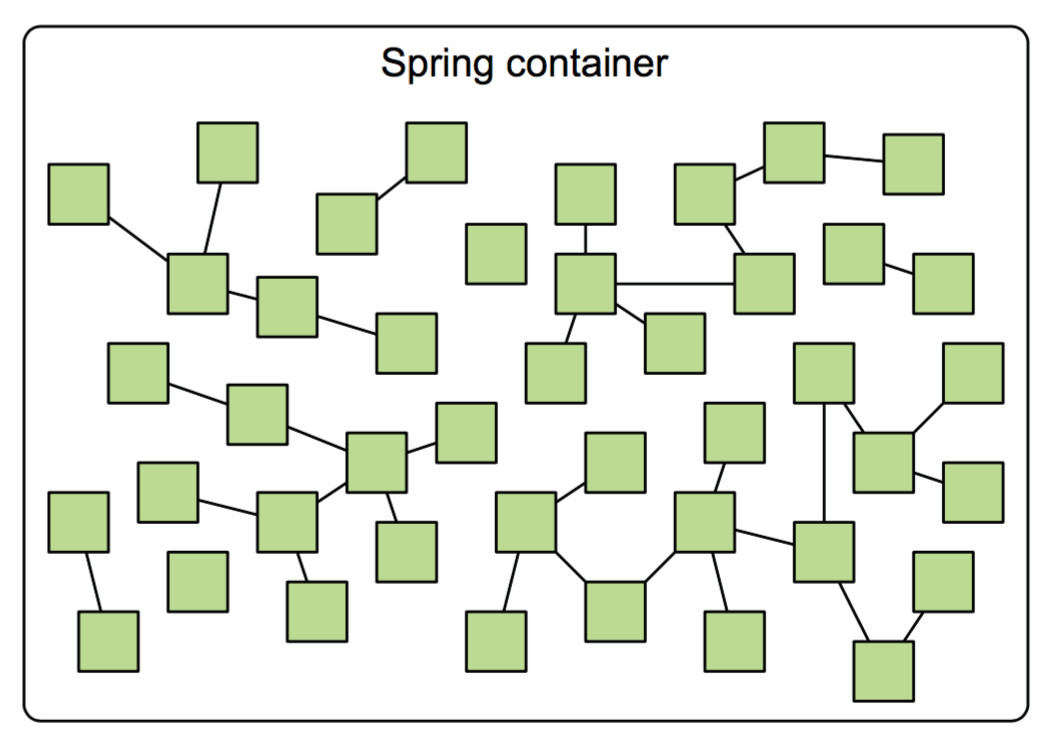
Spring Container
Spring provides the following two interfaces that act as containers. The org.springframework.beans and org.springframework.context packages are the basis for Spring Framework’s IoC container
- BeanFactory: This is a basic container, and all other containers implement BeanFactory
- ApplicationContext: This refers to the subinterface of BeanFactory and is mostly used as a container in enterprise applications
Bean Factory
What is Bean Factory



Spring Bean Factory

Application Context
ApplicationContext is also used to represent Spring Container, built upon the BeanFactory interface. ApplicationContext is suitable for Java EE applications, and it is always preferred over BeanFactory. All functionality of BeanFactory is included in ApplicationContext
- AnnotationConfigApplicationContext - Loads a Spring application context from one or more Java-based configuration classes
- AnnotationConfigWebApplicationContext - Loads a Spring web application context from one or more Java-based configuration classes
- ClassPathXmlApplicationContext - Loads a context definition from one or more XML files located in the classpath, treating context-definition files as class- path resources
- FileSystemXmlApplicationContext - Loads a context definition from one or more XML files in the filesystem
- XmlWebApplicationContext - Loads context definitions from one or more XML files contained in a web application
Application Context

WebApplication Context
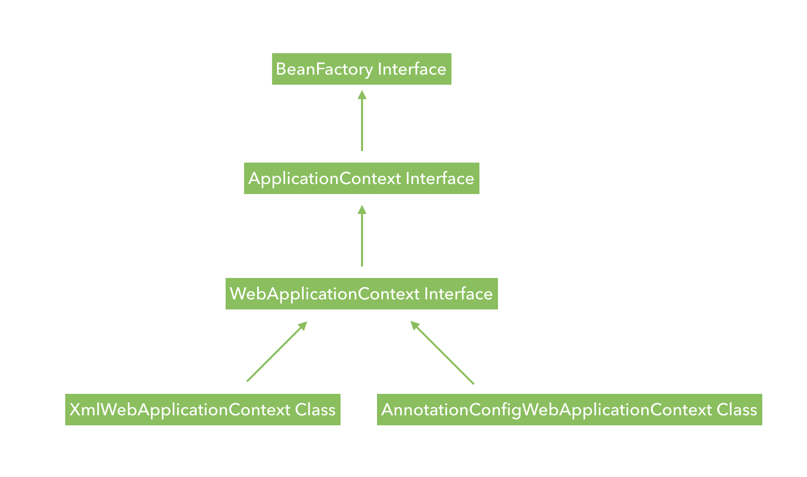
Configuration Application Context
Basic Configuration Overview
Simple Spring XML Configuration
<?xml version="1.0" encoding="UTF-8"?>
<beans xmlns="http://www.springframework.org/schema/beans"
xmlns:xsi="http://www.w3.org/2001/XMLSchema-instance"
xsi:schemaLocation="http://www.springframework.org/schema/beans
http://www.springframework.org/schema/beans/spring-beans.xsd">
</beans>
Basic Configuration Overview
Spring XML Configuration with Annotation Support
<?xml version="1.0" encoding="UTF-8"?>
<beans xmlns="http://www.springframework.org/schema/beans"
xmlns:xsi="http://www.w3.org/2001/XMLSchema-instance"
xmlns:context="http://www.springframework.org/schema/context"
xsi:schemaLocation="http://www.springframework.org/schema/beans
http://www.springframework.org/schema/beans/spring-beans.xsd
http://www.springframework.org/schema/context
http://www.springframework.org/schema/context/spring-context.xsd">
<context:component-scan base-package="com.assanai.annotation" />
</beans>
XML-based configuration metadata
<beans xmlns="http://www.springframework.org/schema/beans"
xmlns:xsi="http://www.w3.org/2001/XMLSchema-instance"
xmlns:context="http://www.springframework.org/schema/context"
xsi:schemaLocation="http://www.springframework.org/schema/beans
http://www.springframework.org/schema/beans/spring-beans.xsd
http://www.springframework.org/schema/context
http://www.springframework.org/schema/context/spring-context.xsd">
<context:component-scan base-package="com.assanai.annotation" />
</beans>
Working with BeanFactory
InputStream is = new FileInputStream("beans.xml");
BeanFactory factory = new XmlBeanFactory(is);
HelloWorld obj = (HelloWorld) factory.getBean("helloWorld");
Working with Application Context
Instantiating a container
ApplicationContext context = new ClassPathXmlApplicationContext(new String[] {"services.xml", "daos.xml"});
ApplicationContext context = new FileSystemXmlApplicationContext("c:/foo.xml");
ApplicationContext context = new AnnotationConfigApplicationContext(UserConfig.class);
Using the container
With an application context in hand, you can retrieve beans from the Spring container by calling the context’s getBean() method.
// create and configure beans
ApplicationContext context = new ClassPathXmlApplicationContext(new String[] {"services.xml", "daos.xml"});
// retrieve configured instance
PetStoreService service = context.getBean("petStore", PetStoreService.class);
// use configured instance
List<String> userList = service.getUsernameList();
Spring-Manage Beans
What is Bean?
- Typical java bean with a unique id
- In spring there are basically two types Singleton, Prototype (non-singleton)
Bean overview
A Spring IoC container manages one or more beans. These beans are created with the configuration metadata that you supply to the container, for example, in the form of XML <bean/> definitions.
Bean Naming Conventions
The convention is to use the standard Java convention for instance field names when naming beans. That is, bean names start with a lowercase letter, and are camel-cased.
'accountManager', 'accountService', 'userDao', 'loginController'
What is a bean definition?
Defines a bean for Spring to manage
- class (required): fully qualified java class name
- id: the unique identifier for this bean
- configuration: (singleton, init-method, etc.)
- constructor-arg: arguments to pass to the constructor at creation time
- property: arguments to pass to the bean setters at creation time
- Collaborators: other beans needed in this bean (a.k.a dependencies), specified in property or constructor-arg
Sample bean definition
1
public class ExampleBean {
private AnotherBean beanOne;
private YetAnotherBean beanTwo;
private int i;
public void setBeanOne(AnotherBean beanOne) { this.beanOne = beanOne; }
public void setBeanTwo(YetAnotherBean beanTwo) { this.beanTwo = beanTwo; }
public void setIntegerProperty(int i) { this.i = i; }
}
Dependency Injection
“An injection is the passing of a dependency (a service) to a dependent object (a client). Passing the service to the client, rather than allowing a client to build or find the service, is the fundamental requirement of the pattern.”
Dependency Injection in Spring
Dependency Injection in Spring
- Constructor Injection
- By invoking a constructor containing a number of arguments, constructor-based DI can be accomplished. These arguments are injected at the time of instance instantiation.
- Setter Injection
- Setter-based DI is attained by calling setter methods on your beans. Using setter methods defined in a Spring configuration file, the dependencies are "set" in the objects.
Dependency Injection in Spring

Constructor Injection
Pass dependencies in via constructor
<constructor-arg value="Joe Doe"/>
equals
GreetingServiceImpl greetingService = new GreetingServiceImpl(“Joe Doe”);
Example Constructor-Injection
public class SimpleMovieLister {
// the SimpleMovieLister has a dependency on a MovieFinder
private MovieFinder movieFinder;
// a constructor so that the Spring container can inject a MovieFinder
public SimpleMovieLister(MovieFinder movieFinder) {
this.movieFinder = movieFinder;
}
// business logic that actually uses the injected MovieFinder is omitted...
}
<constructor-arg ref="movieFinder"/>
<bean id="movieFinder" class="example.hello.MovieFinder" />
Constructor argument resolution
package x.y;
public class Foo {
public Foo(Bar bar, Baz baz) {
// ...
}
}
<bean id="foo" class="x.y.Foo">
<constructor-arg ref="bar"/>
<constructor-arg ref="baz"/>
</bean>
<bean id="bar" class="x.y.Bar"/>
<bean id="baz" class="x.y.Baz"/>
No potential ambiguity exists, assuming that Bar and Baz classes are not related by inheritance. Thus the following configuration works fine, and you do not need to specify the constructor argument indexes and/or types explicitly in the <constructor-arg> element.
Resolving ambiguity
public Employee(String employeeName, int employeeAge, boolean married) {
this.employeeName = employeeName;
this.employeeAge = employeeAge;
this.married = married;
}
<constructor-arg value="Assani Manurat" />
<constructor-arg value="False" />
<constructor-arg value="28" />
If the orders in which constructor-arg is deined are not matching, then you will get the following error:
Exception in thread "main" org.springframework.beans.factory.
UnsatisfiedDependencyException: Error creating bean with name employee defined in the classpath
resource [beans.xml]: Unsatisfied dependency expressed through
constructor argument with index 1 of type [int]: Could not convert
constructor argument value of type [java.lang.String] to required
type [int]: Failed to convert value of type 'java.lang.String' to
required type 'int'; nested exception is java.lang.NumberFormatException: For input string: "False"
Solution – use index attribute
<constructor-arg value="Assani Manurat" index="0"/>
<constructor-arg value="False" index="2" />
<constructor-arg value="28" index="1" />
Remember that the index attribute always starts with 0.
Solution – use type attribute
<constructor-arg value="Assanai Manurat" type="java.lang.String"/>
<constructor-arg value="False" type="java.lang.Boolean" />
<constructor-arg value="28" type="java.lang.Integer" />
The solution to this problem is to use the type attribute to specify the exact data type for the constructor
Setter Injection
Pass dependencies in via property setters
equals
GreetingServiceImpl greetingService = new GreetingServiceImpl();
greetingService.setGreeting("Hello");
Setter Injection (2)
public class ExampleBean {
private AnotherBean beanOne;
private YetAnotherBean beanTwo;
private int integerProperty;
public void setBeanOne(AnotherBean beanOne) {
this.beanOne = beanOne;
}
public void setBeanTwo(YetAnotherBean beanTwo) {
this.beanTwo = beanTwo;
}
public void setIntegerProperty(int integerProperty) {
this.integerProperty = integerProperty;
}
}
<bean id="exampleBean" class="examples.ExampleBean">
<property name="beanOne">
<ref bean="anotherExampleBean"/>
</property>
<!-- setter injection using the neater ref attribute -->
<property name="beanTwo" ref="yetAnotherBean"/>
<property name="integerProperty" value="1"/>
</bean>
<bean id="anotherExampleBean" class="examples.AnotherBean"/>
<bean id="yetAnotherBean" class="examples.YetAnotherBean"/>
Try...
Additional Features
- Importing configuration files
- Autowing
Importing configuration files
xml-service-config.xml
xml-repository-config.xml
xml-context-config.xml
Autowiring
- Advantages
- can significantly reduce the need to specify properties or constructor arguments
- can update a configuration as your objects evolve
- Disadvantages
- cannot autowire simple properties (primitives)
Autowiring modes
- No
- (Default) No autowiring. Bean references must be defined via a ref element
- byName
- Autowiring by property name. Spring looks for a bean with the same name as the property that needs to be autowired
- byType
- Allows a property to be autowired if exactly one bean of the property type exists in the container. If more than one exists, a fatal exception is thrown, which indicates that you may not use byType autowiring for that bean
Autowiring modes
- constructor
- this is similar to autowire byType, but here the constructor is used to inject a dependency
Stereotype
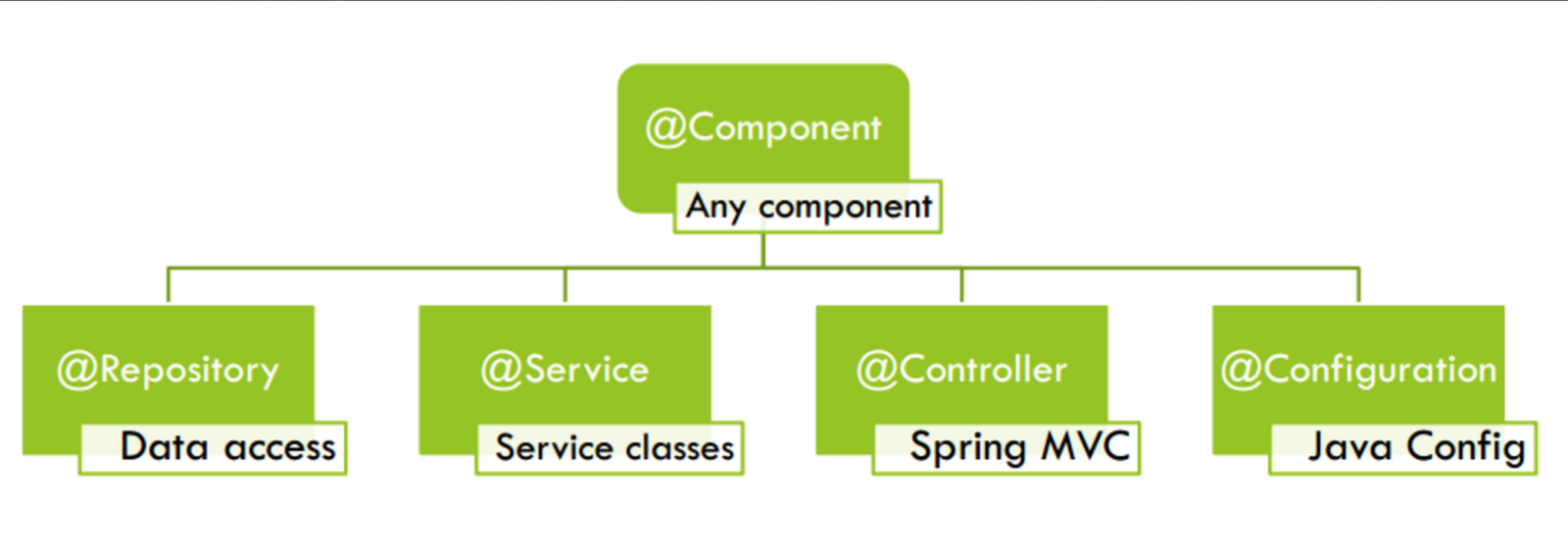
Basic configuration
<context:annotation-config />
<context:component-scan base-package="org.example"/>
<context:annotation-config/> is configured, you can start annotating your code to indicate that Spring should automatically wire values into properties, methods, and constructors.
@Autowired
public class SimpleMovieLister {
private MovieFinder movieFinder;
@Autowired
public void setMovieFinder(MovieFinder movieFinder) {
this.movieFinder = movieFinder;
}
// ...
}
As expected, you can apply the @Autowired annotation to "traditional" setter methods
@Autowired
You can apply @Autowired to constructors and fields
public class MovieRecommender {
@Autowired
private MovieCatalog movieCatalog;
private CustomerPreferenceDao customerPreferenceDao;
@Autowired
public MovieRecommender(CustomerPreferenceDao customerPreferenceDao) {
this.customerPreferenceDao = customerPreferenceDao;
}
// ...
}
@Resource
- Spring also supports injection using the JSR-250 @Resource annotation on fields or bean property setter methods.
- This is a common pattern in Java EE 5 and 6, for example in JSF 1.2 managed beans or JAX-WS 2.0 endpoints.
- Spring supports this pattern for Spring-managed objects as well
public class SimpleMovieLister {
private MovieFinder movieFinder;
@Resource(name="myMovieFinder")
public void setMovieFinder(MovieFinder movieFinder) {
this.movieFinder = movieFinder;
}
}
Detecting classes and Registering bean definitions
@Service
public class SimpleMovieLister {
private MovieFinder movieFinder;
@Autowired
public SimpleMovieLister(MovieFinder movieFinder) {
this.movieFinder = movieFinder;
}
}
@Repository
public class JpaMovieFinder implements MovieFinder {
// implementation elided for clarity
}
Spring can automatically detect stereotyped classes and register corresponding BeanDefinitions with the ApplicationContext
Detecting classes and Registering bean definitions
To autodetect these classes and register the corresponding beans, you need to add @ComponentScan to your @Configuration class
@Configuration
@ComponentScan(basePackages = "org.example")
public class AppConfig {
...
}
alternative using XML
<context:component-scan base-package="org.example"/>
Providing a scope for autodetected components
Default and most common scope for autodetected components is singleton
Sometimes you need other scopes, which Spring 2.5 provides with a new @Scope annotation
@Scope("prototype")
@Repository
public class MovieFinderImpl implements MovieFinder {
// ...
}
Try...
Spring Bean Scopes
| Scope | Description |
|---|---|
| singleton | This scopes the bean definition to a single instance per Spring IoC container (default). |
| prototype | This scopes a single bean definition to have any number of object instances. |
| request | This scopes a bean definition to an HTTP request. Only valid in the context of a web-aware Spring ApplicationContext. |
| session | This scopes a bean definition to an HTTP session. Only valid in the context of a web-aware Spring ApplicationContext. |
| global-session | This scopes a bean definition to a global HTTP session. Only valid in the context of a web-aware Spring ApplicationContext. |
Singleton

Prototype
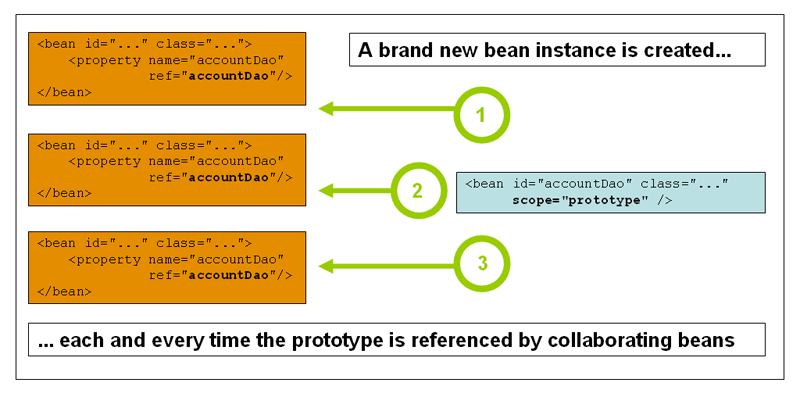
Request, session, global session
“ The request, session, and global session scopes are only available if you use a web-aware Spring ApplicationContext implementation (such as XmlWebApplicationContext).
If you use these scopes with regular Spring IoC containers such as the ClassPathXmlApplicationContext, you get an IllegalStateException complaining about an unknown bean scope. ”